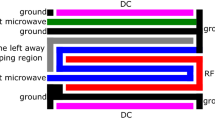Abstract
We present new ways of trapping a neutral atom with static electric and magnetic fields. We discuss the interaction of a neutral atom with the magnetic field of a current carrying wire and the electric field of a charged wire. Atoms can be trapped by the 1/r magnetic field of a current-carrying wire in a two-dimensional trap. The atoms move in Kepler-like orbits around the wire and angular momentum prevents them from being absorbed at the wire. Trapping was demonstrated in an experiment by guiding atoms along a 1 m long current-carrying wire. Stable traps using the interaction of a polarizable atom with the electric field of a charged wire alone are not possible because of the 1/r 2 form of the interaction potential. Nevertheless, we show that one can build a microscopic trap with a combination of a magnetic field generated by a current in a straight wire and the static electric field generated by a concentric charged ring which provides the longitudinal confinement. In all of these traps, the neutral atoms are trapped in a region of maximal field, in theirhigh-field seeking state.
Similar content being viewed by others
References
A good overview is given in H. Demelt: Rev. Mod. Phys.62, 521 (1990). H. Walther:Laser Manipulation of Atoms and Ions, ed. by E. Arimondo, W.D. Phillips, F. Strumia (North-Holland, Amsterdam 1992) p. 569 R. Blümel, J.M. Chen, E. Peik, W. Quint, W. Schleich, Y.R. Shen, H. Walther: Nature (London)334, 309 (1988)
E. Arimondo, W.D. Phillips, F. Strumia (eds.):Laser Manipulation of Atoms and Ions (North-Holland, Amsterdam 1992) Special issue onLaser Cooling and Trapping of Atoms: J. Opt. Soc. Am. B.6 (Nov. 1989)
A good overview is given in W. Paul: Rev. Mod. Phys.62, 531 (1990)
K. Klueger, K. Moritz, W. Paul, U. Trinks: Nucl. Instrum. Methods228, 240 (1985)
N. Masuhara, J. Doyle, J. Sandberg, D. Kleppner, T. Greytak, H. Hess, G. Kochanski: Phys. Rev. Lett.61, 935 (1988)
A. Migdall, J. Prodan, W. Phillips, T. Bergman, H. Metcalf: Phys. Rev. Lett.54, 2596 (1985) E.A. Cornell, Ch. Monroe, C.E. Wieman: Phys. Rev. Lett.67, 2439 (1991)
A. Lagendijk, I.F. Silvera, B.J. Verhaar: Phys. Rev. B33, 626 (1986)
W. Wing: Prog. Quant. Electron.8, 181 (1984)
W. Ketterle, D. Pritchard: Appl. Phys. B54, 403 (1992)
V.V. Vladimirskii: Sov. Phys.-JETP12, 740 (1961)
A. Shapere, F. Wilczek (eds):Geometric Phases in Physics (World Scientific, Singapore 1988)
Y. Aharonov, A Stern: Phys. Phys. Rev. Lett.69, 3593 1992) A Stern: Phys. Rev. Lett.68, 1022 (1992) Y. Aharonov, E. Ben-Reuven, S. Popescu, D. Rohrlide: Phys. Rev. Lett.65, 3065 (1990) J. Anandan, Y. Aharonov: Phys. Rev. Lett.65, 1697 (1990)
A. Messiah:Quantum Mechanics (de Gruyter, Berlin 1979) Chap. XVII)
This is only true if the magnetic field is low enough and one can neglect the internal structure of the atom, i.e., the Zeeman energy has to be much smaller than the hyperfine splitting. This is fulfilled in all the cases discussed here
L.D. Landau, E.M. Lifshitz:Classical Mechanics (Pergamon, Oxford 1977) Chaps. 14, 15
T. Uzer, D. Forrelly, J.A. Milligan, P.L. Raynes, J.P. Skelton: Science253, 42 (1991)
A.I. Voronin: Phys. Rev. A43, 29 (1991)
R. Blümel, K. Dietrich: Phys. Rev. A43, 22 (1991)
A. Scrinzi: Private communications (1994)
M. Wilkinson: J. Phys. A17, 3459 (1984) H. Kratsuji, S. Iida: Prog. Theor. Phys.74, 439 (1985)
X.L. Yang, H.S. Guo, F.T. Chan, K.W. Wong, W.Y. Ching: Phys. Rev. A43, 1186 (1991)
J. Schmiedmayer: Phys. Rev. Lett. (1994) (submitted)
N. Ramsey:Molecular Bems (Oxford Univ. Press. Oxford 1985) p. 37
For a review see: M. Wilkins Phys. Rev. A (1994) (submitted)
L. Hau, M. Burns, J. Golovchenko: Phys. Rev. A45, 6468 (1992)
H. Lamb:Dynamics (Cambridge Univ. Press, Cambridge 1929)
L.D. Landau, E.M. Lifshitz:Quantum Mechanics (Pergamon, Oxford 1977) p. 54
K.M. Case: Phys. Rev.80, 797 (1950)
P.M. Morse, H. Feshbach:Mechods of Theoretical Physics, Vol. II (McGraw-Hill, New York 1953) p. 1665
L. Hau: Private communication L. Hau: to be published
J.M. Levy-Leblond: Phys. Rev.153, 1 (1967) C. Desfrancois, B. Baillon, J.P. Sohermann, S.T. Arnold, J.H. Hendrieks, K.H. Bowen: Phys. Rev. Lett.72, 48 (1994) C. Desfrancois, H. Abdoul-Carime, N. Khelifa, J.P. Schermann: Phys. Rev. Lett.73, 2436 (1994)
H. Baatelan, R. Abfatterer, S. Wehinger, J. Schmiedmayer: InProc. Europ. Quant. Electron. Conf. (1994) (in press)
B. Kramer (ed):Quantum Coherence in Mesoscopic Systems NATO ASI Ser. B, Vol. 254 (Plenum, New York 1991)
Author information
Authors and Affiliations
Additional information
Dedicated to H. Walther on the occasion of his 60th birthday




